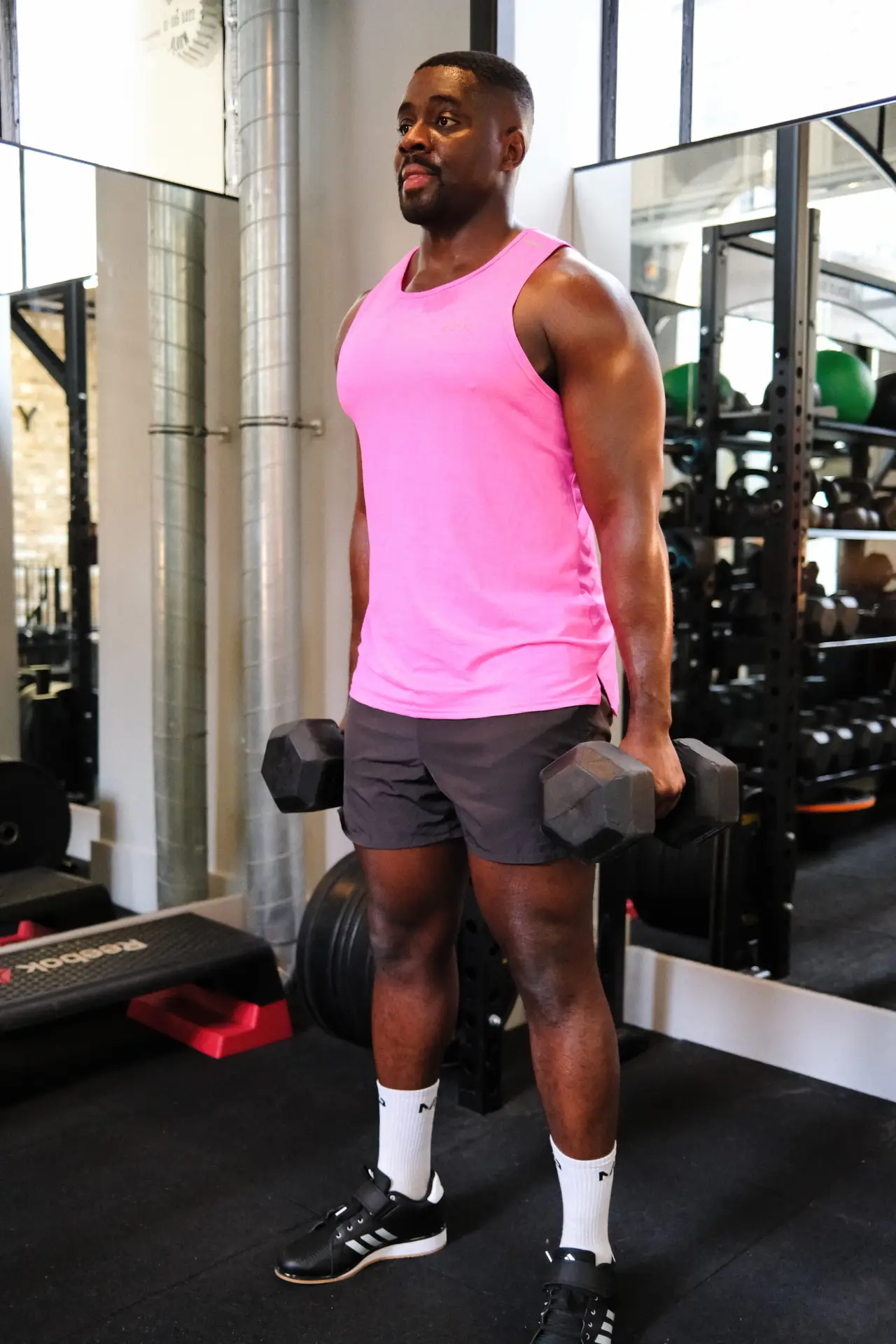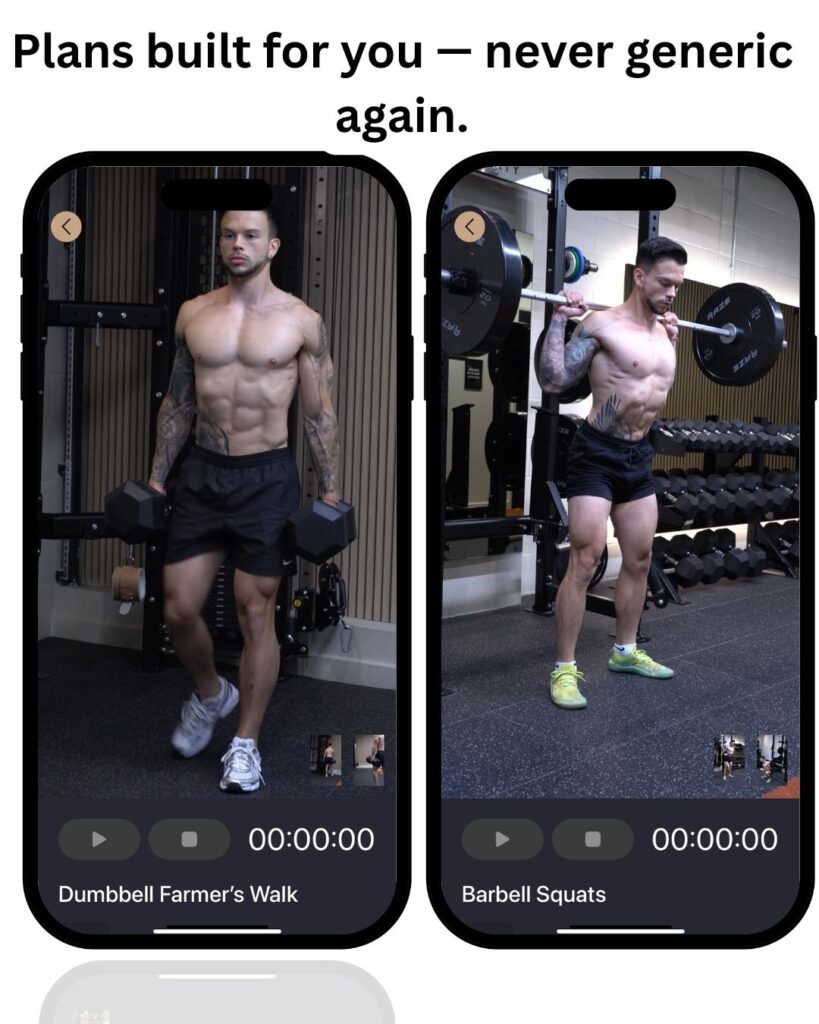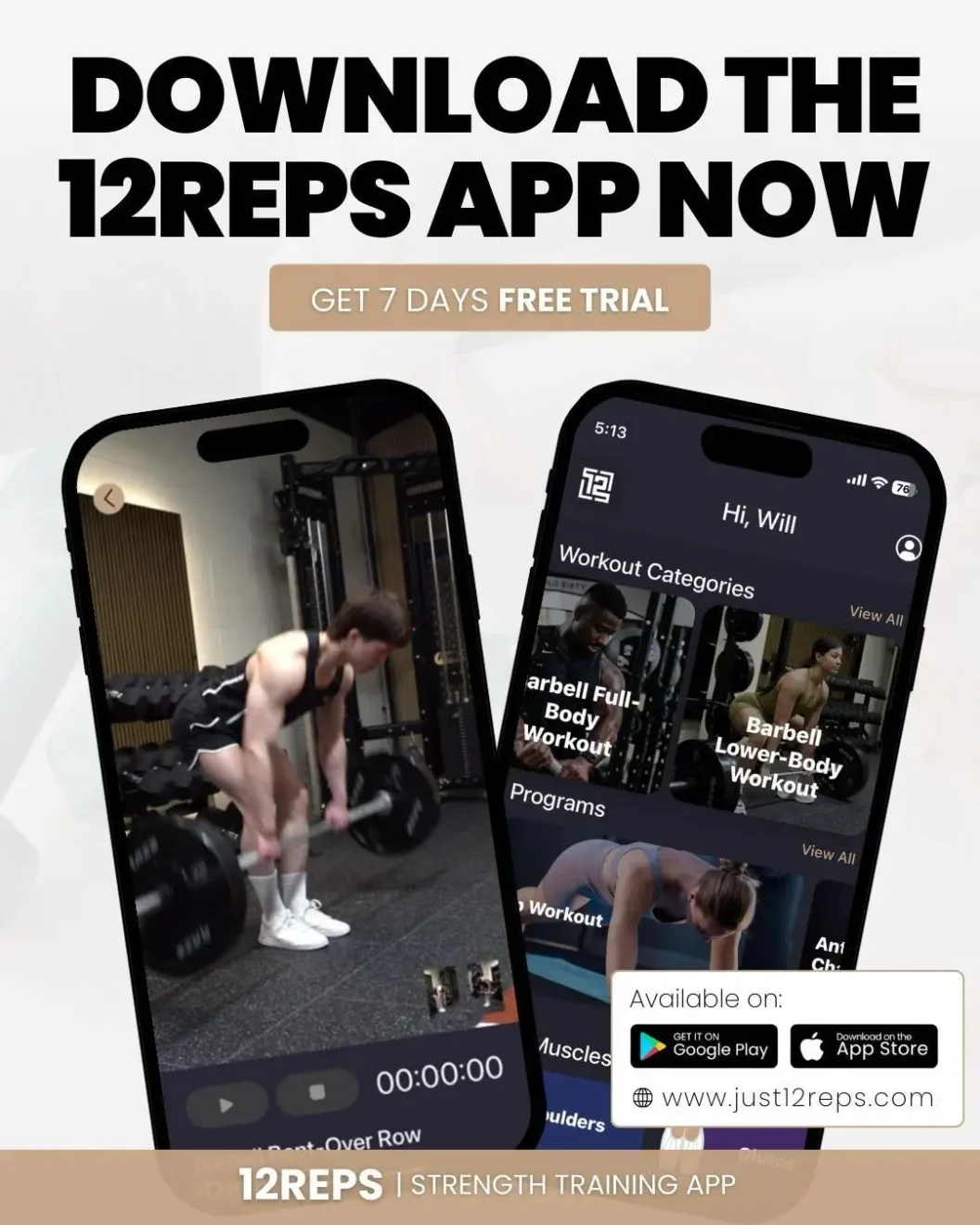By Will Duru, BSc (Hons) Sport and Exercise Science, Award-winning Personal Trainer with over 10 years of experience in strength training and optimising recovery
Choosing the right exercises can make or break your 12-rep training program. After 10 years of training people, I’ve learned that exercise selection is just as important as the number of reps or the weight you lift.
Many people think all exercises are created equal. They believe that as long as they’re doing 12 reps, any exercise will work. This couldn’t be further from the truth. The exercises you choose determine how effectively you build muscle, how safely you can train, and how consistently you can progress over time.
In my experience, the wrong exercise choices are one of the biggest reasons people plateau or get injured. I’ve seen clients struggle for months with exercises that simply don’t work well for 12-rep training, then make incredible progress once we switched to better options.
The good news is that exercise selection doesn’t have to be complicated. There are clear principles that guide which exercises work best for 12-rep training, and I’m going to share them all with you.
In this guide, you’ll learn exactly how to choose exercises that maximise muscle activation, minimise injury risk, and allow for consistent progression. I’ll cover the best upper body and lower body exercises for 12-rep training, how to sequence them in your workouts, and common mistakes to avoid.
By the end, you’ll have a complete framework for selecting exercises that work perfectly with the 12-rep approach. You’ll understand why some exercises are superior to others and how to build programs that deliver results week after week.The 12reps app automatically selects the most effective exercises for your goals and available equipment, taking all the guesswork out of program design. But understanding the principles behind these choices will make you a smarter, more successful trainee.
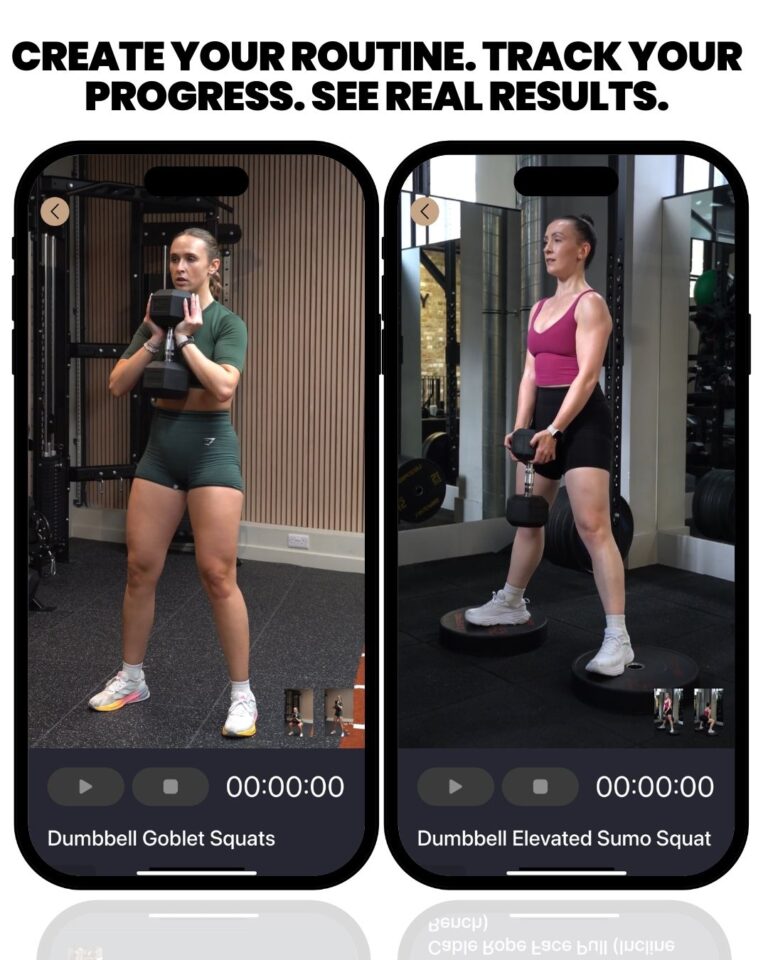
Principles of Exercise Selection for 12-Rep Training
Not all exercises work equally well for 12-rep training. After years of studying exercise science and training hundreds of clients, I’ve identified the key principles that determine which exercises are optimal for this rep range.
Joint-Friendly Movement Patterns
When you’re doing 12 reps, you’re performing each exercise 12 times per set, potentially for multiple sets. This higher volume means the exercise needs to be kind to your joints. Movements that feel fine for 5 reps can become problematic when you’re doing 12 reps multiple times.
The best exercises for 12-rep training allow your joints to move through their natural range of motion without excessive stress. They should feel smooth and controlled throughout the entire movement, not forced or uncomfortable.
I always look for exercises that work with your body’s natural mechanics rather than against them. This is why I prefer dumbbell exercises over some barbell variations for 12-rep training. Dumbbells allow for more natural movement patterns and reduce joint stress.
High Muscle Activation Efficiency
For 12-rep training to be effective, the exercises you choose need to activate a lot of muscle fibers efficiently. Research shows that exercise selection significantly impacts muscle activation patterns, which directly affects your results [1].
The most effective exercises for 12-rep training are those that create high levels of muscle activation without requiring perfect technique under fatigue. As you get tired during a 12-rep set, your form will naturally deteriorate slightly. The best exercises remain safe and effective even when you’re fatigued.
Compound exercises generally provide better muscle activation efficiency than isolation exercises because they work multiple muscle groups simultaneously. However, the right isolation exercises can be incredibly valuable for targeting specific muscles that might not get fully activated by compound movements alone.
Progressive Overload Potential
One of the most important factors in exercise selection is whether you can progressively overload the movement over time. The best exercises for 12-rep training allow you to gradually increase the challenge in multiple ways.
You should be able to add weight, increase reps, improve range of motion, or enhance control and tempo. Exercises that only allow for one type of progression will eventually limit your long-term progress.
I also look for exercises that work well across a wide range of weights. Some exercises feel great with light weights, but become awkward or dangerous as you get stronger. The best 12-rep exercises remain effective whether you’re using 10-pound dumbbells or 50-pound dumbbells
Form Maintenance Under Fatigue
This is crucial for 12-rep training. By rep 10, 11, and 12, you’re going to be tired. The exercises you choose need to be forgiving enough that small form breakdowns don’t lead to injury.
Exercises with complex movement patterns or high coordination requirements often become dangerous when you’re fatigued. The best 12-rep exercises have relatively simple movement patterns that you can maintain even when your muscles are burning.
I prefer exercises where the weight is supported or guided in some way, reducing the risk of losing control when fatigue sets in. This is why I often choose dumbbell chest press over barbell bench press for 12-rep training, especially with beginners.
Equipment Versatility and Accessibility
The best exercises for 12-rep training work well with commonly available equipment. You shouldn’t need specialised machines or setups that are only available in certain gyms.
Dumbbell exercises are particularly valuable because they’re available in virtually every gym and can be used at home. Bodyweight exercises are also excellent because they require no equipment at all.
I always consider whether an exercise can be modified based on available equipment. The best exercises have multiple variations that work with different setups, ensuring you can always train effectively regardless of your situation.
Safety Under Volume
Finally, the exercises you choose need to remain safe when performed for higher volumes. Some exercises that are perfectly safe for 5 reps become risky when you’re doing 12 reps for multiple sets.
This is particularly important for exercises involving the spine or complex movement patterns. The cumulative stress of higher volume training means safety margins become even more important.
The 12reps app automatically selects the most effective exercises for your goals and available equipment, applying all these principles to ensure you get maximum results with minimum risk.
Upper Body Exercise Selection
Choosing the right upper body exercises for 12-rep training requires understanding how different movements work with this rep range. Let me break down the best options for each movement pattern.
Horizontal Pushing Movements
For horizontal pushing, I prefer the dumbbell chest press over the barbell bench press for 12-rep training. Here’s why: dumbbells allow for a more natural movement pattern, reduce shoulder stress, and remain safe even when you’re fatigued.
The dumbbell chest press lets each arm work independently, which helps correct imbalances and provides a better stretch at the bottom of the movement. When you’re doing 12 reps, this natural movement pattern becomes increasingly important as fatigue sets in.
Push-ups are also excellent for 12-rep training, especially for beginners or when training at home. You can easily modify the difficulty by changing the angle (incline push-ups on a bench) or adding resistance with a weighted vest.
I avoid barbell bench press for most 12-rep training because it becomes risky when you’re fatigued. Getting stuck under a barbell on rep 11 or 12 is dangerous, while dumbbells can simply be dropped safely.
Vertical Pushing Movements
For overhead pressing, the seated dumbbell shoulder press is my top choice for 12-rep training. The seated position provides back support, reducing the risk of lower back strain during higher volume training.
Standing overhead press can work for 12-rep training, but it requires excellent core stability and perfect form throughout all 12 reps. Most people’s form breaks down as they fatigue, making the seated version safer and more effective.
Pike push-ups are an excellent bodyweight option for vertical pushing. They’re challenging enough to be effective for 12 reps while remaining safe and accessible for most people.
Horizontal Pulling Movements
Dumbbell rows are perfect for 12-rep training. They’re joint-friendly, allow for excellent muscle activation, and can be performed safely even when fatigued. I prefer single-arm dumbbell rows because they allow you to support yourself with your free hand.
Seated cable rows are also excellent if you have access to a cable machine. The seated position and guided movement pattern make them very safe for higher volume training.
Bent-over barbell rows can work for 12-rep training, but they require excellent form and core stability. I generally reserve these for more advanced trainees who have mastered the movement pattern.
Vertical Pulling Movements
Pull-ups and chin-ups are challenging for 12-rep training because most people can’t do 12 quality reps. However, they’re excellent exercises if you can perform them with good form.
For most people, I recommend assisted pull-ups using resistance bands or an assisted pull-up machine. This allows you to work in the 12-rep range while building toward unassisted pull-ups.
Lat pulldowns are the most accessible vertical pulling exercise for 12-rep training. They allow you to adjust the resistance precisely and maintain good form throughout all 12 reps.
Isolation Exercises for Targeted Development
While compound exercises should form the foundation of your program, isolation exercises have an important place in 12-rep training. They allow you to target specific muscles that might not get fully activated by compound movements.
For biceps, dumbbell curls are perfect for 12-rep training. The movement is simple, safe, and allows for excellent muscle activation. Hammer curls are also excellent and work the biceps from a different angle.
For triceps, overhead dumbbell extensions and tricep dips work well for 12 reps. These exercises provide excellent muscle activation while remaining safe under fatigue.
For shoulders, lateral raises and rear delt flies are ideal isolation exercises for 12-rep training. They target the smaller shoulder muscles that are not fully engaged by pressing movements.
Common Mistakes in Upper Body Exercise Selection
The biggest mistake I see is choosing exercises that are too complex or require too much coordination for 12-rep training. Exercises like barbell bench press or standing overhead press can become dangerous when you’re fatigued.
Another common mistake is neglecting pulling movements. Many people focus too heavily on pushing exercises, creating imbalances that lead to poor posture and increased risk of injury.
Finally, many people choose isolation exercises that don’t provide enough muscle activation to justify their place in a 12-rep program. Stick to isolation exercises that create a strong muscle contraction and allow for progressive overload.
Research shows that exercise selection significantly impacts muscle activation patterns [2], so choosing the right exercises is crucial for maximising your results from 12-rep training.

Lower Body Exercise Selection
Lower body exercise selection for 12-rep training requires special attention to safety and effectiveness. The larger muscle groups and heavier weights involved make the choice of exercise even more critical.
Squat Variations and Applications
For 12-rep training, I prefer goblet squats and dumbbell squats over barbell back squats for most people. Here’s why: the weight is held in front of your body, which naturally encourages better posture and reduces spinal loading.
Goblet squats are particularly excellent for 12-rep training. Holding a dumbbell at chest level provides counterbalance, making it easier to maintain proper form throughout all 12 reps. The movement is also self-limiting; you can’t use weights that are too heavy.
Dumbbell squats (holding dumbbells at your sides) are another great option. They allow for heavier loading than goblet squats while maintaining the safety benefits of not having weight on your back.
Barbell back squats can work for 12-rep training, but they require excellent form and experience. The risk of form breakdown under fatigue makes them less ideal for most people doing higher rep training.
For beginners or those with mobility limitations, bodyweight squats are perfect for building up to weighted versions. You can make them more challenging by adding pauses or changing the tempo.
Deadlift Patterns and Safety Considerations
Deadlifts are tricky for 12-rep training because they’re technically demanding and involve heavy weights. However, when done correctly, they’re incredibly effective for building the entire posterior chain.
Romanian deadlifts (RDLs) are my preferred deadlift variation for 12-rep training. They have a shorter range of motion than conventional deadlifts, making them easier to perform with good form when fatigued. They also provide excellent hamstring and glute activation.
Dumbbell deadlifts are safer than barbell versions for 12-rep training. The lighter weight and more natural grip position reduce the risk of form breakdown. You can perform both conventional and Romanian deadlift patterns with dumbbells.
Trap bar deadlifts are excellent if you have access to a trap bar. The neutral grip and more upright position make them safer and more comfortable for higher rep training.
I generally avoid conventional barbell deadlifts for 12-rep training with most clients. The technical demands and heavy loading make them risky when performed for higher reps, especially as fatigue sets in.
Single-Leg Exercises and Unilateral Training
Single-leg exercises are fantastic for 12-rep training because they’re naturally self-limiting in terms of weight, making them safer while still being highly effective.
Lunges are perfect for 12-rep training. You can perform them with bodyweight, dumbbells, or even a barbell across your back. The movement is functional, works multiple muscle groups, and allows for excellent progression.
Step-ups are another excellent single-leg exercise for 12-rep training. They’re joint-friendly, functional, and can be made more challenging by increasing step height or adding weight.
Bulgarian split squats are more advanced but incredibly effective for 12-rep training. They provide an excellent stretch for the hip flexors while building single-leg strength and stability.
Single-leg deadlifts are challenging but excellent for developing balance, stability, and posterior chain strength. Start with bodyweight and progress to holding dumbbells.
Posterior Chain Development Priorities
The posterior chain (glutes, hamstrings, and lower back) is often underdeveloped in most people, making it a priority in 12-rep training programs.
Hip thrusts are excellent for 12-rep training. They specifically target the glutes while being very safe and easy to learn. You can perform them with bodyweight, dumbbells, or a barbell.
Glute bridges are a simpler version of hip thrusts that work perfectly for beginners or as a warm-up exercise. They’re safe, effective, and require no equipment.
Good mornings can work for 12-rep training but require careful attention to form. I prefer to use them with lighter weights and focus on the hip hinge movement pattern.
Integration of Compound and Isolation Movements
While compound exercises should form the foundation of your lower body training, isolation exercises can help target specific muscles that might be lagging.
Calf raises are perfect for 12-rep training. They’re simple, safe, and allow for excellent muscle activation. You can perform them with bodyweight or add dumbbells for extra resistance.
Leg curls (if you have access to a machine) are excellent for targeting the hamstrings specifically. They complement the compound movements and help ensure balanced development.
Leg extensions can be useful for quad development, but I prefer compound movements like squats and lunges for most people. If you do use leg extensions, focus on controlled movement and avoid locking out the knees aggressively.
Common Lower Body Exercise Selection Mistakes
The biggest mistake is choosing exercises that are too technically demanding for 12-rep training. Complex movements like Olympic lifts or heavy barbell squats become dangerous when performed for higher reps as fatigue sets in.
Another common mistake is neglecting single-leg training. Unilateral exercises are incredibly valuable for correcting imbalances and building functional strength.
Finally, many people focus too heavily on quad-dominant exercises and neglect the posterior chain. Make sure your program includes plenty of hip hinge movements and glute activation exercises.
Research on muscle activation during different exercises shows that exercise selection significantly impacts which muscles are worked and how effectively [3]. This makes choosing the right exercises crucial for balanced development.
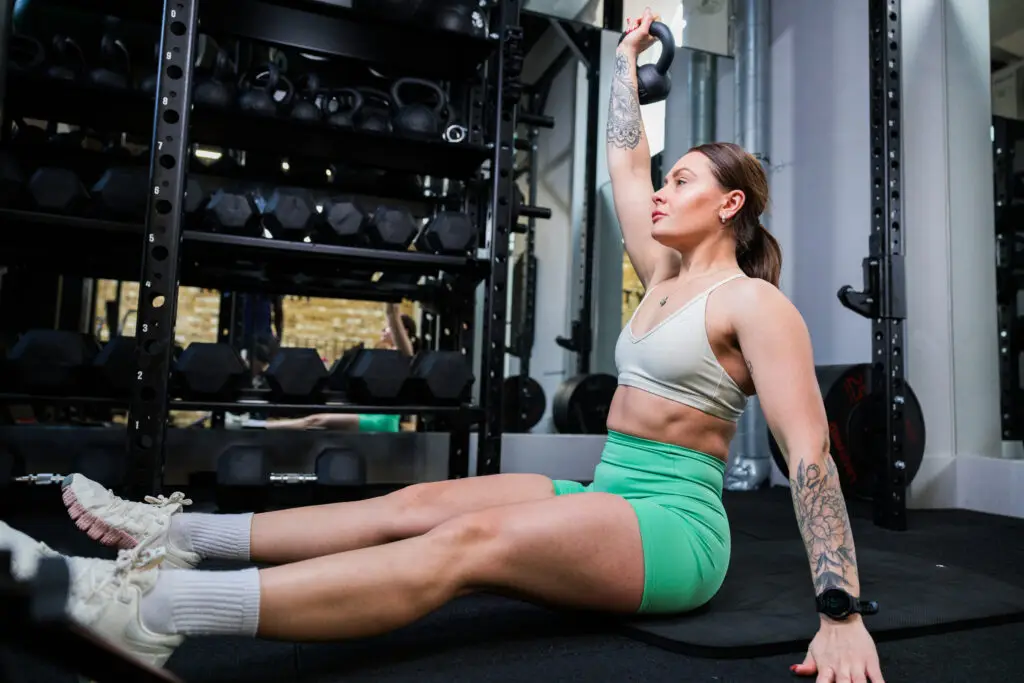
Program Integration and Exercise Ordering
Selecting great exercises is only half the battle. How you organise and sequence these exercises within your workouts determines how effectively you can perform them and how well you’ll recover between sessions.
Sequencing Exercises Within Workouts
The order of exercises in your workout has a huge impact on your performance and results. After 10 years of training people, I’ve learned that proper sequencing can make the difference between a great workout and a mediocre one.
Always start with your most technically demanding exercises when you’re fresh. For 12-rep training, this usually means compound movements like squats, deadlifts, or rows. These exercises require the most coordination and stability, so you want to perform them when your nervous system is at its best.
Follow compound exercises with less complex movements that target similar muscle groups. For example, after squats, you might do lunges or leg press. This allows you to continue working the same muscles while reducing the technical demands.
Finish with isolation exercises that target specific muscles. These exercises are less demanding and can be performed effectively even when you’re fatigued. They’re also great for addressing any weak points or imbalances.
Balancing Compound and Isolation Movements
For 12-rep training, I recommend a foundation of compound exercises supplemented with targeted isolation work. A good rule of thumb is 70% compound exercises and 30% isolation exercises.
Compound exercises give you the most bang for your buck. They work multiple muscle groups simultaneously, provide functional strength, and are time-efficient. Exercises like squats, deadlifts, rows, and presses should form the core of your program.
Isolation exercises serve specific purposes: targeting muscles that might not get fully activated by compound movements, addressing imbalances, and providing additional volume for muscles you want to emphasise.
The key is using isolation exercises strategically rather than randomly. Each isolation exercise should have a specific purpose in your program, whether it’s building bigger arms, strengthening weak glutes, or improving shoulder stability.
Fatigue Management and Exercise Order
Managing fatigue is crucial for 12-rep training because you’re performing relatively high volumes. Poor exercise ordering can lead to premature fatigue and reduced performance on important exercises.
Never perform isolation exercises before compound exercises that work the same muscles. For example, don’t do bicep curls before pull-ups, or leg extensions before squats. The isolation exercise will pre-fatigue the muscle, reducing your performance on the more important compound movement.
Consider the overlap between exercises when planning your sequence. If you’re doing bench press and shoulder press in the same workout, the bench press will partially fatigue your shoulders, affecting your shoulder press performance. Plan accordingly by either separating these exercises or adjusting your expectations.
Use antagonist pairings to manage fatigue effectively. Pairing exercises that work opposite muscle groups (like chest and back) allows one muscle group to rest while the other works. This can actually improve performance and save time.
Superset and Circuit Considerations
Supersets and circuits can be excellent for 12-rep training when used appropriately. They save time and can increase the metabolic demand of your workouts.
Antagonist supersets work particularly well for 12-rep training. Pairing exercises like rows and chest press, or squats and hip thrusts, allows you to work efficiently while maintaining good performance on both exercises.
Avoid agonist supersets (exercises that work the same muscles) for your main compound movements. Doing squats immediately followed by lunges will compromise your performance on the second exercise.
Circuits can work well for 12-rep training, especially for conditioning or when time is limited. However, make sure the exercises in your circuit don’t interfere with each other. A circuit of squats, push-ups, and rows works well because each exercise uses different muscle groups.
Weekly Programming and Exercise Rotation
For 12-rep training, I recommend training each muscle group 2-3 times per week. This frequency works well with the moderate intensity of 12-rep training and allows for optimal recovery.
You don’t need to change exercises constantly. Stick with effective exercises for 4-6 weeks before making changes. This allows you to master the movement patterns and make consistent progress.
When you do change exercises, make small modifications rather than complete overhauls. For example, switch from dumbbell chest press to incline dumbbell press, or from regular squats to goblet squats.
Consider your weekly schedule when planning exercise selection. If you train three times per week, you might do full-body workouts with the same exercises each session. If you train four or more times per week, you can split your training and use different exercises on different days.
Recovery Considerations
Exercise selection affects recovery demands. Some exercises are more systemically demanding than others, requiring more recovery time.
Heavy compound exercises like deadlifts and squats are the most demanding and should be programmed carefully. You might only deadlift once per week while squatting twice per week.
Isolation exercises are generally less demanding and can be performed more frequently. You could do bicep curls or calf raises every training session without issues.
Consider the cumulative stress of your exercise selection. A workout with squats, deadlifts, and rows will be much more demanding than one with leg press, leg curls, and lat pulldowns, even if the rep ranges are the same.
Proper exercise sequencing is complex, but the 12reps app handles all the programming details automatically. It considers exercise order, fatigue management, and recovery demands to create optimal workouts for your goals.
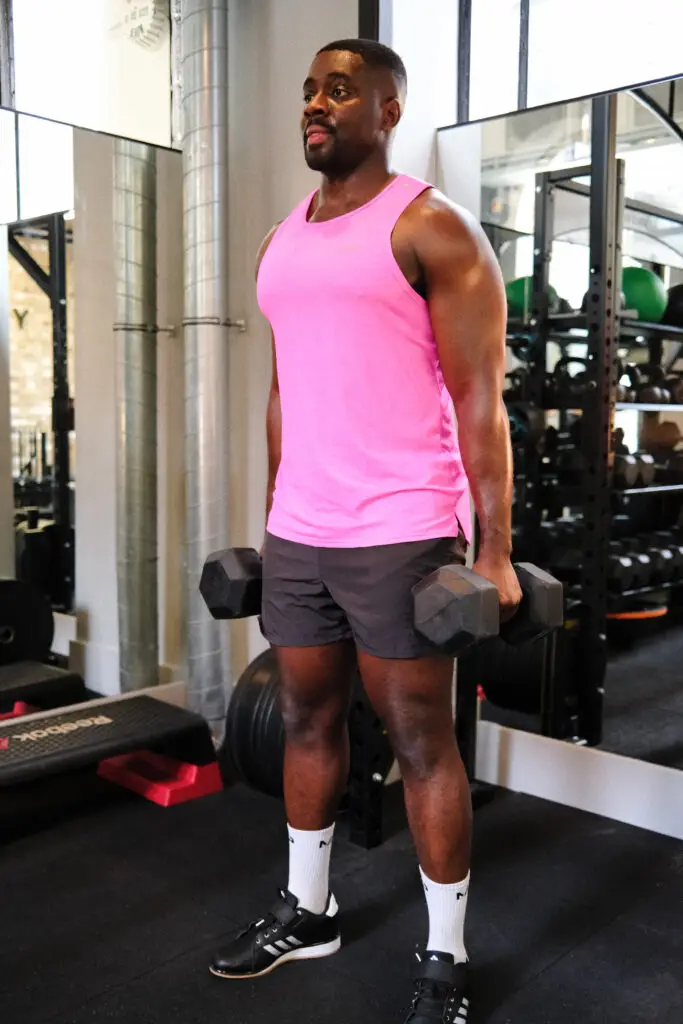
Conclusion
Exercise selection is the foundation of effective 12-rep training. The exercises you choose determine how safely you can train, how effectively you build muscle, and how consistently you can progress over time.
The key principles I’ve shared, joint-friendly movements, high muscle activation, progressive overload potential, form maintenance under fatigue, and equipment versatility, should guide every exercise choice you make.
For upper body training, focus on dumbbell exercises that allow natural movement patterns and remain safe under fatigue. Compound movements like dumbbell chest press, rows, and shoulder press should form your foundation, supplemented with targeted isolation work.
For lower body training, prioritise exercises that work well for higher volumes while maintaining safety. Goblet squats, Romanian deadlifts, and single-leg exercises are excellent choices that provide great results with lower injury risk.
Remember that exercise selection is just one piece of the puzzle. How you sequence exercises, manage fatigue, and program your training over time is equally important for long-term success.
The beauty of 12-rep training is that it works well with a wide variety of exercises, giving you flexibility while maintaining effectiveness. You don’t need access to specialised equipment or complex movements to get excellent results.
Most importantly, choose exercises that you can perform consistently over months and years. The best exercise on paper is worthless if you can’t or won’t do it regularly. Focus on movements that feel good, challenge you appropriately, and fit your lifestyle and available equipment.
Ready for perfectly programmed workouts with optimal exercise selection? The 12reps app takes the guesswork out of exercise choice and sequencing, automatically creating workouts that maximise your results while minimising injury risk.
Your exercise choices today determine your results tomorrow. Choose wisely, train consistently, and trust the process. The right exercises, performed with the right rep range, will transform your body and your life.
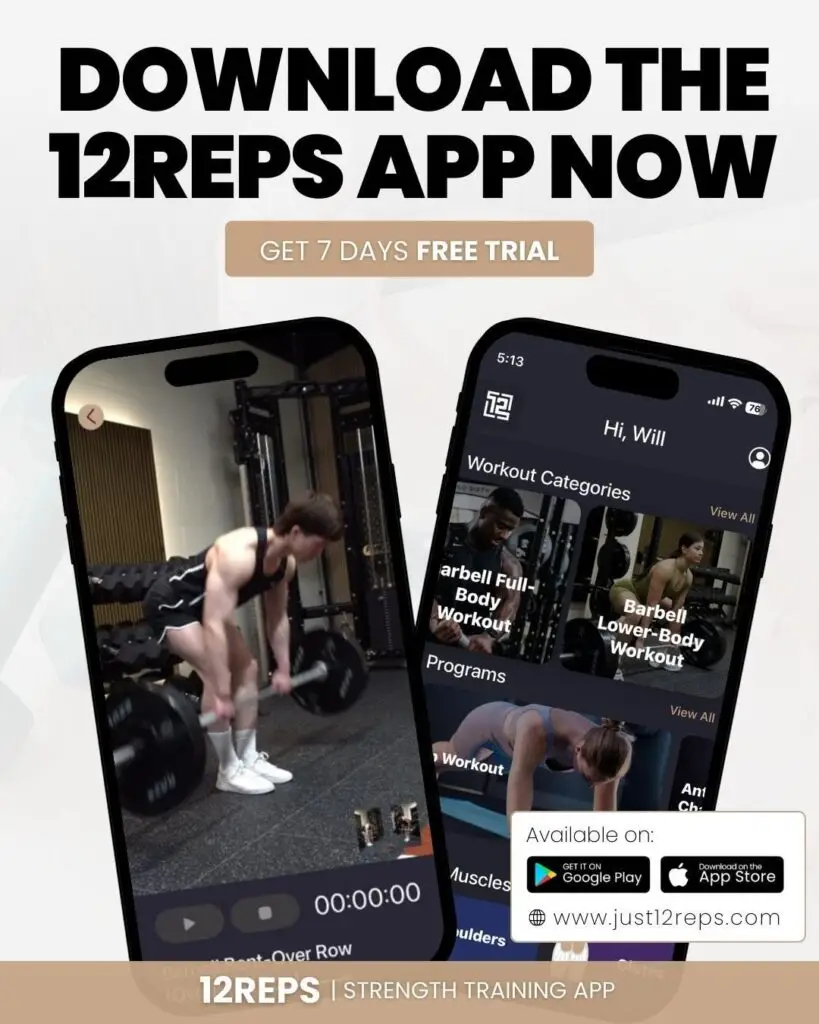
Scientific References
[1] Bourne, M. N., Williams, M. D., Opar, D. A., et al. (2017). Impact of exercise selection on hamstring muscle activation. *British Journal of Sports Medicine*, 51(13), 1021-1028. https://bjsm.bmj.com/content/51/13/1021.short
[2] Schoenfeld, B. J., Contreras, B., Tiryaki-Sonmez, G., et al. (2015). Regional differences in muscle activation during hamstrings exercise. *Journal of Strength and Conditioning Research*, 29(1), 159-164. https://journals.lww.com/nsca-jscr/fulltext/2015/01000/Regional_Differences_in_Muscle_Activation_During.20.aspx
[3] Ebben, W. P., Feldmann, C. R., Dayne, A., et al. (2009). Muscle activation during lower body resistance training. *International Journal of Sports Medicine*, 30(1), 1-8. https://www.thieme-connect.com/products/all/doi/10.1055/s-2008-1038785

